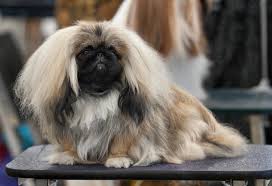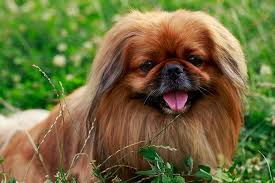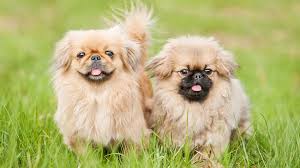The Pekingese, also known as the “Lion Dog” due to its resemblance to the Chinese guardian lions, is a beloved toy breed that has captured the hearts of dog lovers around the world. With its distinctive flat face, bulging eyes, and flowing coat, this tiny yet mighty dog has a big personality that belies its small size.
Originating in ancient China, the Pekingese was bred as a companion for Chinese royalty and nobility. Legend has it that the dogs were so highly prized that they were kept in the royal palace and were considered sacred. In fact, it was believed that if anyone other than the emperor or empress owned a Pekingese, they would be punished with death.
Today, the Pekingese is a popular pet in many parts of the world, thanks to its charming personality, loyalty, and adaptability. Despite its regal history, the Pekingese is a playful and affectionate companion that loves nothing more than cuddling up with its owner.
One of the most distinctive features of the Pekingese is its flat face, which gives it a distinctive look that is instantly recognizable. However, this unique facial structure can also cause health problems for the breed, including respiratory issues and eye problems. As such, it’s important for Pekingese owners to be aware of the potential health risks associated with the breed and to take steps to keep their pets healthy and happy.
Despite its small size, the Pekingese has a surprisingly big personality. These dogs are known for their stubbornness and can be difficult to train, but with patience and perseverance, they can be taught to obey basic commands. They are also fiercely loyal to their owners and can be quite protective, making them excellent watchdogs.
One of the most endearing qualities of the Pekingese is its love of attention. These dogs thrive on affection and will often follow their owners around the house, seeking out pets and cuddles. They are also known for their playful nature and can be quite entertaining to watch as they play with their favorite toys.
Another unique aspect of the Pekingese is its luxurious coat. This long, flowing fur requires regular grooming to keep it looking its best, but many owners find the process of grooming their Pekingese to be a relaxing and enjoyable bonding experience.
In addition, the Pekingese is a unique and lovable breed that has captured the hearts of dog lovers around the world. With its distinctive appearance, big personality, and affectionate nature, it’s easy to see why these dogs are so beloved.
However, potential owners should be aware of the health risks associated with the breed and be prepared to provide their Pekingese with the love, attention, and care that it deserves. So, if you’re looking for a loyal and charming companion that will bring a smile to your face every day, the Pekingese might just be the perfect breed for you.
Read Also: Lhasa Apso Dogs: Description and Complete Care Guide
History and Origin of Pekingese Dogs

The Pekingese has a long and fascinating history that can be traced back to ancient China. The breed was originally known as the “Lion Dog” or “Sun Dog” and was highly prized by the Chinese royal family.
Legend has it that the Pekingese was created by Buddha, who is said to have shrunk a lion down to dog size. According to another legend, a lion fell in love with a marmoset and begged Buddha to shrink him so that he could be with her. Buddha granted the lion’s wish and created the Pekingese.
In reality, the breed was created through careful breeding by the Chinese court. The exact origins of the Pekingese are somewhat murky, but it is believed that the breed was created by crossing various small Chinese dogs with larger Tibetan dogs, such as the Lhasa Apso and the Tibetan Spaniel.
The Pekingese was kept exclusively by Chinese nobility for many centuries, and it was illegal for anyone else to own one. The dogs were highly prized and were often given as gifts to foreign dignitaries. In fact, during the Second Opium War in the 19th century, British troops looted the Chinese imperial palace and stole several Pekingese dogs, which were later given as gifts to Queen Victoria and other members of the British royal family.
The first Pekingese arrived in the United States in the late 19th century, and the breed was officially recognized by the American Kennel Club in 1906. Today, the Pekingese is a popular pet in many parts of the world and is beloved for its charming personality, regal appearance, and playful nature.
Despite its long history, the Pekingese has faced some challenges in recent years. The breed’s distinctive flat face, which is a hallmark of the breed, can cause respiratory problems and other health issues.
Additionally, the breed’s popularity has led to overbreeding and inbreeding, which can lead to a range of health problems. As such, it’s important for potential owners to do their research and to work with reputable breeders to ensure that their Pekingese is healthy and happy.
Health Issues and Lifespan of Pekingese Dogs

One of the most common health issues that Pekingese face is respiratory problems. The breed’s flat face can cause breathing difficulties, particularly in hot weather or when the dog is under stress. Owners should be careful not to over-exercise their Pekingese and should provide plenty of water and a cool, shaded place to rest on hot days.
Pekingese are also prone to eye problems, such as cataracts, corneal ulcers, and cherry eye. These issues can be caused by the shape of the breed’s face and can be worsened by poor breeding practices. Owners should be vigilant about monitoring their Pekingese’s eyes and should seek veterinary care if they notice any issues.
Another potential health issue for Pekingese is obesity. These dogs are prone to overeating and can quickly become overweight if they are not fed a healthy, balanced diet and provided with regular exercise.
The average lifespan of a Pekingese is 12-15 years, although some dogs may live longer with proper care. As with all dogs, regular veterinary care, a healthy diet, and plenty of exercise can help to ensure a long and happy life for your Pekingese.
In addition, while the Pekingese is generally a healthy breed, potential owners should be aware of the breed’s potential health issues and take steps to keep their dogs healthy and happy. Regular veterinary care, a healthy diet, and plenty of exercise can help to prevent many health problems and ensure a long and happy life for your Pekingese.
Pekingese Dog Breed Complete Grooming and Care Guide
Grooming and care are essential aspects of keeping a Pekingese healthy and happy. Here is a complete guide to grooming and caring for your Pekingese:
Brushing: Pekingese have a long, thick coat that requires regular brushing to prevent matting and tangling. Use a soft-bristled brush or a comb to gently brush your Pekingese’s coat at least once a day.
Bathing: Pekingese should be bathed every three to four weeks or as needed. Use a gentle dog shampoo and be sure to rinse your dog thoroughly to prevent skin irritation.
Nail Care: Trim your Pekingese’s nails every few weeks to prevent them from becoming too long and causing discomfort. If you are unsure how to trim your dog’s nails, ask your veterinarian or a professional groomer for assistance.
Ear Cleaning: Pekingese are prone to ear infections, so it is important to clean their ears regularly. Use a gentle ear cleaner and a cotton ball to clean your dog’s ears once a week.
Teeth Cleaning: Dental care is important for Pekingese to prevent tooth decay and gum disease. Brush your dog’s teeth at least once a week with a dog toothbrush and toothpaste.
Exercise: Pekingese are a small breed that requires moderate exercise. Take your Pekingese for daily walks or play games that encourage exercise, such as fetch.
Diet: A healthy diet is essential for a Pekingese’s overall health. Feed your dog a high-quality dog food that is appropriate for their age, size, and activity level.
Training: Pekingese can be stubborn and difficult to train, so it is important to start training early and to use positive reinforcement techniques.
Socialization: Pekingese can be territorial and wary of strangers, so it is important to socialize your dog from a young age. Introduce your dog to new people and experiences gradually to prevent fear and aggression.
Regular Veterinary Care: Pekingese are prone to certain health issues, so it is important to schedule regular veterinary check-ups and to seek veterinary care if you notice any changes in your dog’s behavior or health.
However, by following these grooming and care tips, you can ensure that your Pekingese is healthy, happy, and well-groomed.
Read Also: All you need to know about the Irish Setters Dog Breed
Pekingese Puppies

Socialization: Pekingese puppies need plenty of socialization to prevent fear and aggression. Expose your puppy to different people, animals, and environments from a young age.
House Training: Pekingese puppies can be difficult to house train, so be patient and consistent with your training. Use positive reinforcement techniques and establish a regular routine for your puppy.
Feeding: Pekingese puppies require a balanced and nutritious diet to support their growth and development. Feed your puppy a high-quality puppy food that is appropriate for their age and size.
Exercise: Pekingese puppies require moderate exercise, but be careful not to over-exercise them, as they are prone to respiratory problems. Take your puppy for short walks and play games that encourage exercise, such as fetch.
Grooming: Pekingese puppies have a long, thick coat that requires regular grooming. Brush your puppy’s coat daily to prevent matting and tangling.
Health Care: Pekingese puppies are susceptible to certain health issues, such as respiratory problems and eye problems. Schedule regular veterinary check-ups and seek veterinary care if you notice any changes in your puppy’s behavior or health.
Training: Pekingese puppies can be stubborn and difficult to train, so it is important to start training early and to use positive reinforcement techniques. Use treats, praise, and patience to encourage good behavior.
In conclusion, by providing your Pekingese puppy with proper care, attention, and training, you can ensure that they grow into a healthy and well-behaved adult dog.





